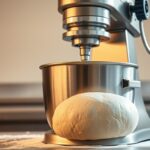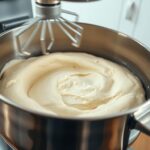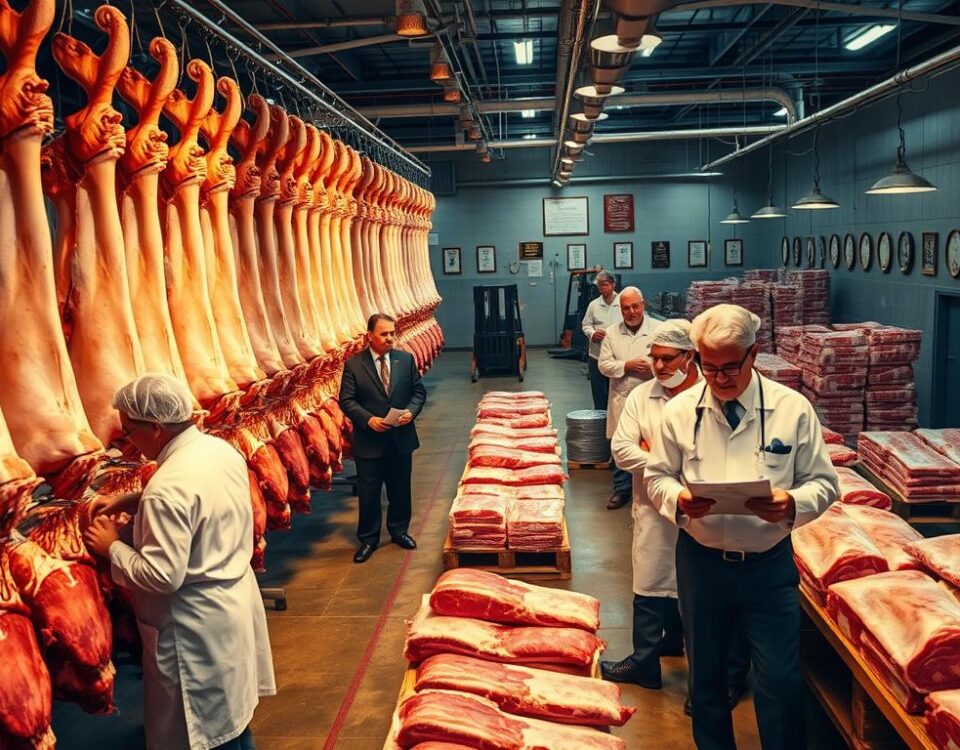
Spiral vs Planetary Mixer: Which One Yields Better Dough?
September 6, 2025
4 Mistakes Bakers Make When Choosing Spiral or Planetary Mixers
September 7, 2025As a home baker, I’ve spent countless hours kneading dough for pizzas and bread, only to end up with inconsistent results. But what if you could achieve perfect crusts every time? With the right mixer, you can.
Did you know that using a stand mixer can reduce kneading time by up to 75%? This not only saves time but also helps to develop the gluten in your dough, resulting in a more tender crumb.
Whether you’re making pizza or bread, the type of mixer you use can greatly impact the final product. In this article, I’ll explore the key differences between mixers designed for pizza dough versus those better suited for bread dough.
Key Takeaways
- Understand the unique characteristics of pizza and bread dough that require different mixing approaches.
- Learn how to choose the right mixer based on your baking frequency, volume needs, and budget.
- Discover practical tips for getting the most out of your mixer, including techniques to improve your dough quality.
- Compare various mixer types, including stand mixers, food processors, and specialty commercial options.
- Find out how to optimize your mixer for the best results with flour and other ingredients.
Understanding the Fundamentals of Dough Mixing
Dough mixing is more than just combining ingredients; it’s a process that affects the final product’s texture and flavor. Whether you’re making pizza or bread, understanding the fundamentals of dough mixing is crucial for achieving the desired outcome.
The Science Behind Gluten Development
The development of gluten is a critical aspect of dough mixing. Gluten provides structure and elasticity to the dough, allowing it to rise and giving the final product its texture. The mixing process directly impacts gluten development. As you mix, the gluten strands begin to form and strengthen, creating a network that traps air bubbles. This is essential for both bread and pizza dough, as it affects their rise and final texture.
| Mixing Method | Gluten Development | Final Product Texture |
|---|---|---|
| Hand Kneading | Variable, depends on kneading intensity and time | Rustic, irregular texture |
| Machine Mixing | Consistent, can be controlled precisely | Uniform structure |
How Mixing Affects Dough Structure and Flavor
The intensity and duration of mixing not only affect gluten development but also the flavor and overall structure of the dough. Overmixing can lead to a dense, tough final product, while undermixing may result in a lack of cohesion. Moreover, the time and method of mixing influence the dough’s temperature, which in turn affects yeast activity during fermentation. A balanced mixing approach is key to achieving the right flavor and texture in your pizza or bread.
By understanding how different mixing methods and intensities impact your dough, you can better control the final product’s characteristics, ensuring a delicious outcome every time.
Pizza vs Bread Dough Mixers: Key Differences
To produce high-quality pizza and bread, it’s essential to understand the key differences in their dough mixers. The process of mixing dough is crucial for developing gluten, which affects the texture and structure of the final product.
Power and Speed Requirements
The power and speed required for mixing dough vary significantly between pizza and bread dough. Pizza dough, often with lower hydration levels, requires more powerful mixing to incorporate ingredients thoroughly. In contrast, bread dough, which can have higher hydration, may need gentler mixing to avoid over-developing the gluten. A mixer’s ability to adjust speed is crucial for handling different dough types effectively. For instance, a stand mixer with variable speed can be beneficial for both pizza and bread dough preparation.
While the stand mixer heats the dough a little bit, it doesn’t get nearly as warm as a dough kneaded in a food processor, so you can knead for a much longer time without any fear of overheating the yeast.
Bowl Capacity and Design Considerations
Bowl capacity and design play a significant role in dough mixing. Deeper bowls are often more suitable for bread dough, as they allow for more efficient mixing and less dough splashing. On the other hand, wider bowls may be preferable for pizza dough, facilitating easier access and manipulation of the dough. The material of the bowl also affects heat retention during mixing, impacting dough temperature differently for pizza versus bread preparation.
| Dough Type | Bowl Preference | Mixing Consideration |
|---|---|---|
| Pizza Dough | Wider Bowl | Easier access for lower hydration dough |
| Bread Dough | Deeper Bowl | More efficient mixing for higher hydration dough |

Pizza Dough Characteristics and Mixing Needs
Pizza dough has distinct characteristics that require specific mixing needs to achieve the perfect crust. As a baker, understanding these characteristics is crucial for producing high-quality pizza.
Lower Hydration and Higher Oil Content
One of the primary characteristics of pizza dough is its lower hydration level compared to bread dough. This lower hydration, combined with a higher oil content, affects the dough’s mixing requirements. The reduced water content means less gluten development is needed, while the increased oil content can make the dough more tender but also more prone to overmixing. To achieve the right balance, I recommend using a mixing technique that gently combines the ingredients without overdeveloping the gluten.
| Dough Characteristics | Mixing Requirements |
|---|---|
| Lower Hydration | Less gluten development needed |
| Higher Oil Content | Risk of overmixing; tender crust |
Shorter Fermentation Times
Another key characteristic of pizza dough is its shorter fermentation time. Unlike artisan bread, which often undergoes a longer, slower fermentation process, pizza dough typically ferments for a shorter period. This shorter fermentation time requires a more intense mixing process to jumpstart gluten development and ensure even yeast distribution. I find that using a higher-intensity mixing technique can compensate for the shorter fermentation time, resulting in a well-developed dough with good flavor.
Since the dough coming out of the processor is warm, it also rises faster. This is a plus if you’re in a hurry to get your pizza made, but it’s a disadvantage if you’re hoping for a slow rise for more flavor development. To address this, I adjust the mixing technique to enhance flavor development even with shorter fermentation times typical of pizza dough production.
Bread Dough Characteristics and Mixing Needs
Bread dough has its own unique requirements when it comes to mixing, largely due to its variable hydration levels and longer fermentation times. Understanding these characteristics is crucial for producing high-quality bread.
Variable Hydration Levels
Bread dough can have a wide range of hydration levels, from relatively dry to very wet. This variability affects how the dough is mixed. For instance, a wetter dough may require a more gentle mixing approach to prevent over-developing the gluten. On the other hand, a drier dough might need more vigorous mixing to ensure all ingredients are properly incorporated. The key is to understand the specific hydration level of your dough and adjust your mixing technique accordingly.
Mixing Technique Adjustment is crucial for different hydration levels. For example, wetter doughs benefit from a gentler mix to avoid over-working the gluten, while drier doughs may require more robust mixing to ensure ingredient incorporation.
Longer Fermentation Requirements
Many types of bread dough, especially those for artisan breads, undergo extended fermentation periods, sometimes ranging from 4 to 24 hours or more. This longer fermentation time impacts the mixing process. For longer fermentation, a tiny amount of yeast is often used, requiring thorough mixing to distribute the yeast evenly throughout the dough. Additionally, the mixing intensity should be reduced to prevent excessive oxidation, which can diminish flavor development. Temperature control during mixing is also critical, as the initial temperature affects the entire fermentation timeline.
Temperature control is vital during the mixing process, especially for doughs with long fermentation times. The initial temperature of the dough can significantly impact the fermentation process, making it essential to monitor and control the temperature carefully.
Proper mixing for long-fermentation bread doughs focuses more on ingredient incorporation than complete gluten development, as time will continue the development process. By understanding these needs, bakers can adjust their mixing techniques to produce bread with complex flavors and textures.
Stand Mixers for Dough Preparation

For those who regularly make pizza or bread, a stand mixer can be an indispensable tool in the kitchen. Stand mixers simplify the dough preparation process, saving time and effort while producing consistent results.
Pros and Cons for Pizza Dough
When it comes to pizza dough, stand mixers offer several advantages. They can handle the typically lower hydration and higher oil content of pizza dough with ease, ensuring a well-mixed and developed dough. However, some critics argue that the dough kneaded in a stand mixer is “too organized,” with gluten strands following the spiral pattern of the dough hook rather than being more haphazard as in hand-kneaded dough.
Benefits for Pizza Dough: Stand mixers excel at mixing and kneading pizza dough to the right consistency, saving time and physical effort. They are particularly useful for recipes that require extended mixing.
Consideration: The planetary mixing action may not replicate the rustic texture some pizza makers achieve through hand kneading.
Pros and Cons for Bread Dough
For bread dough, stand mixers are highly effective, especially with medium-hydration doughs. They create a uniform gluten structure, which is beneficial for many types of bread. However, they may struggle with extremely wet or very stiff doughs.
Benefits for Bread Dough: Stand mixers with variable speed controls allow for gentle initial mixing for high-hydration bread doughs, followed by increased speed to develop strength. They save significant time and effort, particularly for recipes requiring extended mixing.
Consideration: There’s a risk of overmixing if not monitored carefully, potentially leading to dense loaves.
Food Processors as Dough Mixers

Food processors are often overlooked as a tool for mixing dough, but they can be incredibly effective. When making pizza or bread, the right mixer can make all the difference in the final product.
Speed Benefits and Temperature Concerns
One of the primary advantages of using a food processor for dough mixing is speed. It can knead dough in a fraction of the time required by hand or even with a stand mixer. However, this rapid kneading can generate heat, potentially affecting yeast activity and dough temperature. It’s crucial to monitor the dough’s temperature to prevent overheating, which can kill the yeast and ruin the dough.
When to Choose a Food Processor Over a Stand Mixer
A food processor is ideal for quick weeknight pizza dough preparation when you need to mix and bake within a short timeframe. It’s also beneficial for doughs with minimal mixing requirements, such as pie crusts and certain flatbreads. Additionally, food processors excel at incorporating fat into flour quickly, making them excellent for pizza doughs that contain olive oil or other fats. However, they are generally not recommended for high-hydration artisan bread doughs that benefit from gentler, longer mixing.
In summary, food processors can be a valuable tool for making dough, especially for pizza and other quick breads. By understanding their benefits and limitations, you can effectively use a food processor to streamline your dough preparation process.
Hand Kneading vs Machine Mixing
Bakers have long debated the merits of hand kneading versus machine mixing, each method offering its own set of advantages and disadvantages. The choice between these two approaches can significantly impact the final product, making it essential to understand their differences.
Texture and Flavor Differences
Hand kneading and machine mixing can produce different textures and flavors in dough. Hand kneading allows for a more tactile approach, enabling bakers to feel the dough’s consistency and make adjustments as needed. This method can result in a more nuanced flavor development due to the gentle handling of the dough. On the other hand, machine mixing is more consistent and can handle larger quantities, potentially leading to a more uniform texture. However, overmixing is a risk with machine mixing, which can result in a denser final product.

Time and Effort Considerations
One of the primary differences between hand kneading and machine mixing is the time and effort required. Hand kneading typically demands 10-15 minutes of continuous physical effort, which can be tiring and straining on the hands and wrists. In contrast, machine mixing is a hands-off approach that allows bakers to prepare other ingredients or clean up while the dough develops, increasing overall efficiency in the kitchen. However, hand kneading can be therapeutic and provide a sense of connection to the bread-making process.
The learning curve also differs between the two methods. Hand kneading requires developing a technique, while machine mixing necessitates understanding the equipment. Bakers must consider their own needs and preferences when deciding which method to invest their time and resources in.
Mixer Features That Matter for Both Pizza and Bread
The features of a dough mixer play a significant role in determining the quality of both pizza and bread dough. When choosing a mixer, several key features can impact the final product’s texture, flavor, and overall quality.
Motor Power and Durability
A robust motor is essential for handling thick dough. Motor power affects the mixer’s ability to knead dough efficiently. A durable motor ensures that the mixer can withstand heavy use, making it a crucial investment for frequent bakers. The right motor power helps in developing the dough properly, whether it’s for pizza or bread.

Dough Hook Design and Efficiency
The design of the dough hook attachment is critical for effective dough mixing. An efficient dough hook helps to develop gluten in the dough, which is crucial for both pizza and bread. Using cold to ice-cold water helps regulate the dough’s temperature and prevents it from becoming too warm due to the friction of the machine, which can affect the dough’s quality. This is particularly important when working with yeast-based dough.
Speed Control Options
Variable speed control is vital for different dough types. I recommend a mixer with at least 6-10 speed settings to provide the versatility needed for gentle incorporation to vigorous development. Key benefits include:
- Slow start features that prevent flour clouds and ingredient splashing.
- Pulse functions that offer precise control for initial mixing phases.
- Electronic speed control that provides consistent power delivery.
Proper speed selection affects dough temperature, with slower speeds generating less friction heat—a crucial consideration for temperature-sensitive doughs. This feature is especially useful when making dough that requires precise temperature control.
Specialty Dough Mixers for High-Volume Baking
Specialty dough mixers are designed to meet the unique needs of high-volume bakeries, offering the power and efficiency required to produce large quantities of dough consistently.
For bakeries that specialize in artisan bread, spiral mixers are an excellent choice. These mixers use a spiral dough hook that gently kneads the dough, preserving the delicate structure of the bread. This results in a more evenly mixed dough with improved texture and flavor.
Spiral Mixers for Artisan Bread
Spiral mixers are particularly well-suited for artisan bread due to their gentle mixing action, which helps maintain the dough’s integrity. This is crucial for producing high-quality bread with a tender crumb and crispy crust.
Planetary Mixers for Versatility
Planetary mixers are another type of specialty dough mixer that offers versatility for bakeries producing a variety of products, including both bread and pizza dough. These mixers feature a powerful motor and interchangeable attachments, making them ideal for handling different types of dough and mixing tasks.
Commercial planetary mixers differ significantly from home stand mixers, offering more power (often 1/2 to 1 horsepower) while maintaining a versatile mixing action. They excel at handling both bread and pizza doughs due to their powerful motors and heavy-duty construction designed for continuous operation.
In conclusion, specialty dough mixers like spiral and planetary mixers are essential for high-volume bakeries, providing the necessary power, efficiency, and versatility to produce high-quality dough consistently. Whether you’re making pizza dough or artisan bread, these mixers can help streamline your production process and improve your final product.
Budget-Friendly Options for Home Bakers
You don’t have to break the bank to get a good dough mixer for your home baking needs. Whether you’re making pizza dough or bread, there are affordable options available that can help you achieve professional-quality results without the hefty price tag.

Entry-Level Stand Mixers
Entry-level stand mixers are a great starting point for home bakers. They offer the power and flexibility needed to mix and knead dough for both pizza and bread. Brands like KitchenAid and Cuisinart offer models that are both affordable and reliable. When choosing an entry-level stand mixer, consider the power of the motor and the capacity of the bowl to ensure it meets your baking needs.
Key Features to Look For: A robust motor, a sufficiently sized bowl, and multiple speed settings are essential for handling various dough types.
Multi-Purpose Appliances with Dough Capabilities
For those with limited kitchen space or on a tighter budget, multi-purpose appliances can be an excellent alternative. Food processors with dough blades, high-powered blenders with dough programs, and bread machines used for their dough cycle can all serve as effective dough mixers. These appliances not only save space but also offer versatility in their use, making them valuable additions to any kitchen.
Adapting Techniques: When using these alternative appliances, it’s crucial to adapt your techniques to achieve the best results. This might involve adjusting ingredient ratios or mixing times.
Mixing Techniques to Improve Your Dough
To produce high-quality dough, understanding and applying effective mixing techniques is essential. The process of mixing is not just about combining ingredients; it’s about developing the dough’s structure and enhancing its flavor.
Autolyse Method for Better Gluten Development
The autolyse method involves mixing flour and water, then allowing the mixture to rest before adding other ingredients. This technique enhances gluten development, resulting in a dough that is more extensible and easier to shape. For both pizza and bread dough, autolyse can significantly improve the final product’s texture and flavor.
Temperature Control During Mixing
Controlling the temperature during mixing is crucial. The ideal temperature for dough depends on the type of dough being made. For instance, pizza dough typically requires a cooler temperature to prevent over-proofing, while bread dough can benefit from a warmer environment to enhance fermentation. Monitoring dough temperature helps in achieving consistent results.
Recognizing Properly Mixed Dough
The dough is ready when it feels smooth, elastic, and pliable. To verify proper gluten development, the “windowpane test” can be performed by stretching a small piece of dough until it’s translucent without tearing. Properly mixed dough should also clear the sides of the mixing bowl while still adhering slightly to the bottom. Different dough types have different indicators of proper development, such as the smooth elasticity of pizza dough and the softer quality of high-hydration bread dough.
By applying these mixing techniques, bakers can significantly improve the quality of their dough, whether they’re making pizza or bread. Understanding the characteristics of properly mixed dough and how to achieve them is key to successful baking.
Common Mixing Mistakes and How to Avoid Them
Mixing dough for pizza or bread can be a nuanced process, and understanding common mistakes is crucial for achieving the perfect loaf or crust. The way you mix your dough can significantly impact its structure and flavor.
Overmixing and Undermixing Issues
Overmixing and undermixing are two common mistakes that can lead to subpar dough. Overmixing can result in a dense, tough crumb due to excessive gluten development. On the other hand, undermixing can lead to a lack of cohesion and uneven fermentation. To avoid these issues, it’s essential to monitor the dough’s consistency and adjust your mixing technique accordingly.
| Mixing Issue | Effect on Dough | Prevention Technique |
|---|---|---|
| Overmixing | Dense, tough crumb | Monitor dough consistency, mix until just combined |
| Undermixing | Lack of cohesion, uneven fermentation | Ensure thorough mixing, check for dough uniformity |
Ingredient Order and Timing
The order and timing of ingredient addition can significantly impact dough development. For instance, adding salt too early can inhibit yeast activity, while delayed salt addition can improve gluten development. Similarly, the timing of fat (oil or butter) addition affects dough strength and texture.
When mixing dough, it’s crucial to consider the order of ingredients. For example, adding salt just before all the water is incorporated can help balance yeast activity and gluten development. The temperature of ingredients, particularly water, also plays a critical role in final dough temperature and subsequent fermentation activity.
- Adding salt too early can inhibit yeast cells, potentially resulting in poor fermentation and rise.
- The order of ingredient addition affects hydration, with techniques like holding back a portion of water to adjust consistency during mixing.
- Delayed salt addition can improve gluten development while providing strengthening benefits to dough structure.
Conclusion: Choosing the Right Mixer for Your Baking Style
As we conclude our exploration of dough mixers for pizza and bread, it’s clear that the right choice depends on your specific baking needs. The key differences between pizza and bread dough mixers lie in their design and functionality, catering to the unique characteristics of each dough type.
When deciding on a mixer, consider your frequency of use, typical batch size, and budget. For frequent bakers, investing in a high-quality mixer that matches your baking style can significantly enhance your results and overall baking experience. Whether you’re making pizza dough or bread dough, the right mixer can make a substantial difference.
Many bakers start with versatile mixers and later expand their collection as their skills and interests evolve. However, it’s crucial to remember that while equipment is important, technique and understanding of dough fundamentals remain the cornerstone of creating exceptional pizza and bread at home. Preheat your oven to the right temperature, and with the right mixer, you’ll be well on your way to baking perfection.
In conclusion, choosing the right mixer involves considering your primary baking focus, the volume of your baking, and your budget. By doing so, you’ll not only improve your baking results but also enhance your overall enjoyment of the process. Whether you’re a seasoned baker or just starting out, the right dough mixer can be a valuable addition to your kitchen arsenal.
FAQ
What’s the main difference between mixing pizza dough and bread dough?
The primary difference lies in their hydration levels and fermentation times. Pizza dough typically has lower hydration and shorter fermentation times, while bread dough can have variable hydration levels and often requires longer fermentation.
Can I use a stand mixer for both pizza dough and bread dough?
Yes, a stand mixer can be used for both, but it’s essential to consider the mixer’s power, speed, and bowl capacity. A more powerful mixer with a suitable dough hook attachment can handle both tasks efficiently.
How does yeast affect the mixing process?
Yeast plays a crucial role in dough fermentation. When mixing, it’s essential to balance the amount of yeast with the right temperature and water to facilitate proper fermentation.
What’s the benefit of using cold water when mixing dough?
Using cold water helps control the dough temperature, slowing down the fermentation process. This can lead to a more complex flavor development and better dough structure.
How long should I knead my dough?
The kneading time depends on the dough type and the mixing method. Generally, hand kneading requires more time than machine kneading. It’s essential to knead until the dough becomes smooth and elastic.
Can I mix dough in a food processor?
Yes, a food processor can be used to mix dough, but it’s crucial to be mindful of the speed and temperature. Overprocessing can lead to overdeveloped gluten, resulting in a tough crust.
How do I know if my dough is properly mixed?
A properly mixed dough should be smooth, elastic, and have a consistent texture. It should also pass the “windowpane test,” where a small piece of dough can be stretched thin without breaking.



